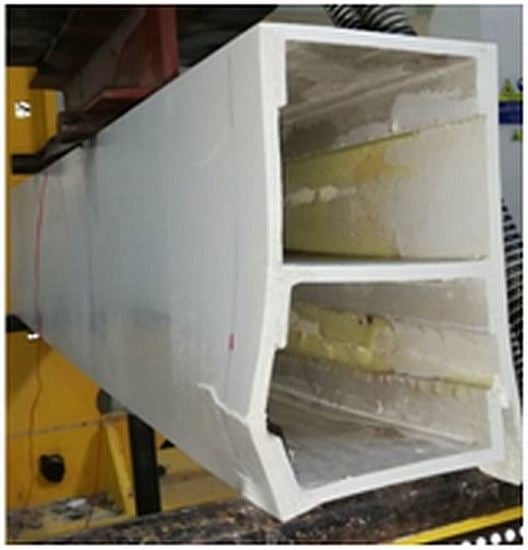Shear Response of Glass Fibre Reinforced Polymer (GFRP) Built-Up Hollow and Lightweight Concrete Filled Beams: An Experimental and Numerical Study
Abstract
1. Introduction
2. Experimental Program
2.1. GFRP Beam Preparation
2.2. Materials Properties and Experimental Setup
3. Experimental Results
4. FE Modelling
4.1. Hashin Damage Model
4.2. Concrete Damaged Plasticity Model
5. Validation and Parametric Study
5.1. Validation of FE Models
5.2. Parametric Study
5.2.1. Effects of GFRP C Channel and Web Thickness
5.2.2. Effectiveness of Longitudinal Stiffener to Restrain Web Buckling
5.2.3. Effects of Different SHS Sections at Corners
6. Conclusions
- (a)
- The GFRP hollow built-up sections failed by web crushing at the supports due to orthotropic material properties of GFRP. The rotational stiffness at the web–flange junction governed the maximum load of the built-up beam, and increasing the thickness of the C channel could improve the maximum load more effectively than increasing the web thickness. The longitudinal C channel stiffener could prevent the web buckling of slender GFRP hollow built-up section, and the maximum load increased by 136% for the web thickness considered in the numerical study.
- (b)
- The built-up section with square hollow sections at corners demonstrated 47% load improvement due to the enhancement of stiffness at the web–flange junction. Increasing the height and thickness of SHS could improve the maximum load of the built-up section. The height of the SHS section showed a greater influence on the maximum load than the thickness of SHS.
- (c)
- Concrete infill improved the stiffness and maximum load by preventing web crushing failure of GFRP section. It achieved the highest maximum load increment of 162% among the parameters considered in this study. It was found that the maximum load was influenced by the bond–slip behaviour at the concrete–GFRP interface, and the failure was caused by the shear crack in the plain concrete core.
Author Contributions
Funding
Acknowledgments
Conflicts of Interest
References
- Keller, T.; Gürtler, H. Composite Action and Adhesive Bond between Fiber-Reinforced Polymer Bridge Decks and Main Girders. J. Compos. Constr. 2005, 9, 360–368. [Google Scholar] [CrossRef]
- Yanes-Armas, S.; de Castro, J.; Keller, T. System transverse in-plane shear stiffness of pultruded GFRP bridge decks. Eng. Struct. 2016, 107, 34–46. [Google Scholar] [CrossRef]
- Yanes-Armas, S.; de Castro, J.; Keller, T. Energy dissipation and recovery in web–flange junctions of pultruded GFRP decks. Compos. Struct. 2016, 148, 168–180. [Google Scholar] [CrossRef]
- Jiang, X.L.; Luo, C.; Qiang, X.; Zhang, Q.; Kolstein, H.; Bijlaard, F. Coupled Hygro-Mechanical Finite Element Method on Determination of the Interlaminar Shear Modulus of Glass Fiber-Reinforced Polymer Laminates in Bridge Decks under Hygrothermal Aging Effects. Polymers 2018, 10, 845. [Google Scholar] [CrossRef] [PubMed]
- Ju, M.P.; Park, K.; Park, C. Punching Shear Behavior of Two-Way Concrete Slabs Reinforced with Glass-Fiber-Reinforced Polymer (GFRP) Bars. Polymers 2018, 10, 893. [Google Scholar] [CrossRef]
- Hosen, M.A.; Alengaram, U.J.; Jumaat, M.Z.; Sulong, N.H.R.; Darain, K.M. Glass Fiber Reinforced Polymer (GFRP) Bars for Enhancing the Flexural Performance of RC Beams Using Side-NSM Technique. Polymers 2017, 9, 180. [Google Scholar] [CrossRef]
- Wang, B.; Bachtiar, E.V.; Yan, L.; Kasal, B.; Fiore, V. Flax, Basalt, E-Glass FRP and Their Hybrid FRP Strengthened Wood Beams: An Experimental Study. Polymers 2019, 11, 1255. [Google Scholar] [CrossRef]
- Mohamed, O.A.; Kewalramani, M.; Khattab, R. Fiber Reinforced Polymer Laminates for Strengthening of RC Slabs against Punching Shear: A Review. Polymers 2020, 12, 685. [Google Scholar] [CrossRef]
- Bai, Y.; Keller, T. Shear Failure of Pultruded Fiber-Reinforced Polymer Composites under Axial Compression. J. Compos. Constr. 2009, 13, 234–242. [Google Scholar] [CrossRef]
- Turvey, G.J.; Zhang, Y. Shear failure strength of web–flange junctions in pultruded GRP WF profiles. Constr. Build. Mater. 2006, 20, 81–89. [Google Scholar] [CrossRef]
- Borowicz, D.T.; Bank, L.C. Behavior of Pultruded Fiber-Reinforced Polymer Beams Subjected to Concentrated Loads in the Plane of the Web. J. Compos. Constr. 2011, 15, 229–238. [Google Scholar] [CrossRef]
- Borowicz, D.T.; Bank, L.C. Web Buckling in Pultruded Fiber-Reinforced Polymer Deep Beams Subjected to Concentrated Loads. J. Compos. Constr. 2014, 18, A4013014. [Google Scholar] [CrossRef]
- Correia, J.R.; Branco, F.A.; Silva, N.M.F.; Camotim, D.; Silvestre, N. First-order, buckling and post-buckling behaviour of GFRP pultruded beams. Part 1: Experimental study. Comput. Struct. 2011, 89, 2052–2064. [Google Scholar] [CrossRef]
- Bai, Y.; Keller, T.; Wu, C. Pre-buckling and post-buckling failure at web-flange junction of pultruded GFRP beams. Mater. Struct. 2013, 46, 1143–1154. [Google Scholar] [CrossRef]
- Wu, C.; Bai, Y. Web crippling behaviour of pultruded glass fibre reinforced polymer sections. Compos. Struct. 2014, 108, 789–800. [Google Scholar] [CrossRef]
- Chen, Y.; Wang, C. Web crippling behavior of pultruded GFRP rectangular hollow sections. Compos. Part. B Eng. 2015, 77, 112–121. [Google Scholar] [CrossRef]
- Chen, Y.; Wang, C. Test on pultruded GFRP I-section under web crippling. Compos. Part. B Eng. 2015, 77, 27–37. [Google Scholar] [CrossRef]
- Fernandes, L.A.; Gonilha, J.; Correia, J.R.; Silvestre, N.; Nunes, F. Web-crippling of GFRP pultruded profiles. Part 1: Experimental study. Compos. Struct. 2015, 120, 565–577. [Google Scholar] [CrossRef]
- Nunes, F.; Silvestre, N.; Correia, J.R. Progressive Damage Analysis of Web Crippling of GFRP Pultruded I-Sections. J. Compos. Constr. 2017, 21, 04016104. [Google Scholar] [CrossRef]
- Fernandes, L.A.; Nunes, F.; Silvestre, N.; Correia, J.R.; Gonilha, J. Web-crippling of GFRP pultruded profiles. Part 2: Numerical analysis and design. Compos. Struct. 2015, 120, 578–590. [Google Scholar] [CrossRef]
- Wu, C.; Zhang, L.; Bai, Y.; Zhao, X.L. Web crippling behavior of pultruded GFRP channel sections under transverse bearing load. Compos. Struct. 2019, 209, 129–142. [Google Scholar] [CrossRef]
- Borowicz, D.T.; Bank, L.C. Effect of web reinforcement on the behavior of pultruded fiber-reinforced polymer beams subjected to concentrated loads. Constr. Build. Mater. 2013, 47, 347–357. [Google Scholar] [CrossRef]
- Gan, L.-H.; Ye, L.; Mai, Y.-W. Optimum design of cross-sectional profiles of pultruded box beams with high ultimate strength. Compos. Struct. 1999, 45, 279–288. [Google Scholar] [CrossRef]
- Muttashar, M.; Manalo, A.; Karunasena, W.; Lokuge, W. Influence of infill concrete strength on the flexural behaviour of pultruded GFRP square beams. Compos. Struct. 2016, 145, 58–67. [Google Scholar] [CrossRef]
- Ferdous, W.; Almutairi, A.D.; Huang, Y.; Bai, Y. Short-term flexural behaviour of concrete filled pultruded GFRP cellular and tubular sections with pin-eye connections for modular retaining wall construction. Compos. Struct. 2018, 206, 1–10. [Google Scholar] [CrossRef]
- Gautam, B.P.; Matsumoto, T. Shear deformation and interface behaviour of concrete-filled CFRP box beams. Compos. Struct. 2009, 89, 20–27. [Google Scholar] [CrossRef]
- Iskander, M.; El-Hacha, R.; Shrive, N. Governing failure criterion of short-span hybrid FRP-UHPC beams subjected to high shear forces. Compos. Struct. 2018, 185, 123–131. [Google Scholar] [CrossRef]
- Ferdous, W.; Manalo, A.; Aravinthan, T. Effect of beam orientation on the static behaviour of phenolic core sandwich composites with different shear span-to-depth ratios. Compos. Struct. 2017, 168, 292–304. [Google Scholar] [CrossRef]
- ASTM Committee D-30 on Composite Materials. Standard Test Method for Tensile Properties of Polymer Matrix Composite Materials. In ASTM D3039; ASTM International: West Conshohocken, PA, USA, 2017. [Google Scholar]
- Øverli, J.A. Towards a better understanding of the ultimate behaviour of LWAC in compression and bending. Eng. Struct. 2017, 151, 821–838. [Google Scholar] [CrossRef]
- Wosatko, A.; Pamin, J.; Polak, M.A. Application of damage–plasticity models in finite element analysis of punching shear. Comput. Struct. 2015, 151, 73–85. [Google Scholar] [CrossRef]
- Navarro, M.; Ivorra, S.; Varona, F.B. Parametric computational analysis for punching shear in RC slabs. Eng. Struct. 2018, 165, 254–263. [Google Scholar] [CrossRef]
- Manual, A.U. Abaqus Theory Guide; section 4.5.6; Dassault Systèmes: Velizy-Villacoublay, France, 2016. [Google Scholar]
- Taerwe, L.; Matthys, S. Fib Model Code for Concrete Structures 2010; Fédération Internationale du Béton: Lausanne, Switzerland, 2013; pp. 82–84. [Google Scholar]
- Abdelatif, A.O.; Owen, J.S.; Hussein, M.F.M. Modelling the prestress transfer in pre-tensioned concrete elements. Finite Elem. Anal. Des. 2015, 94, 47–63. [Google Scholar] [CrossRef]
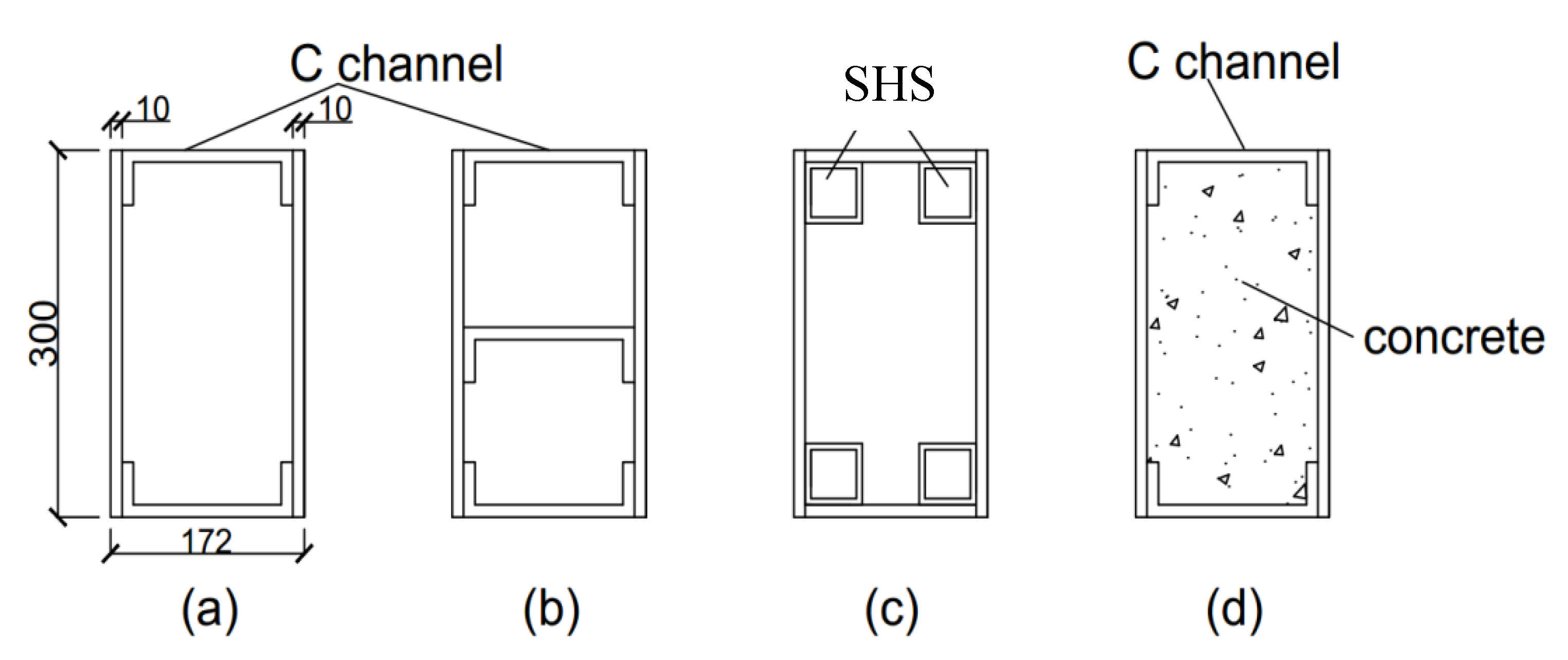
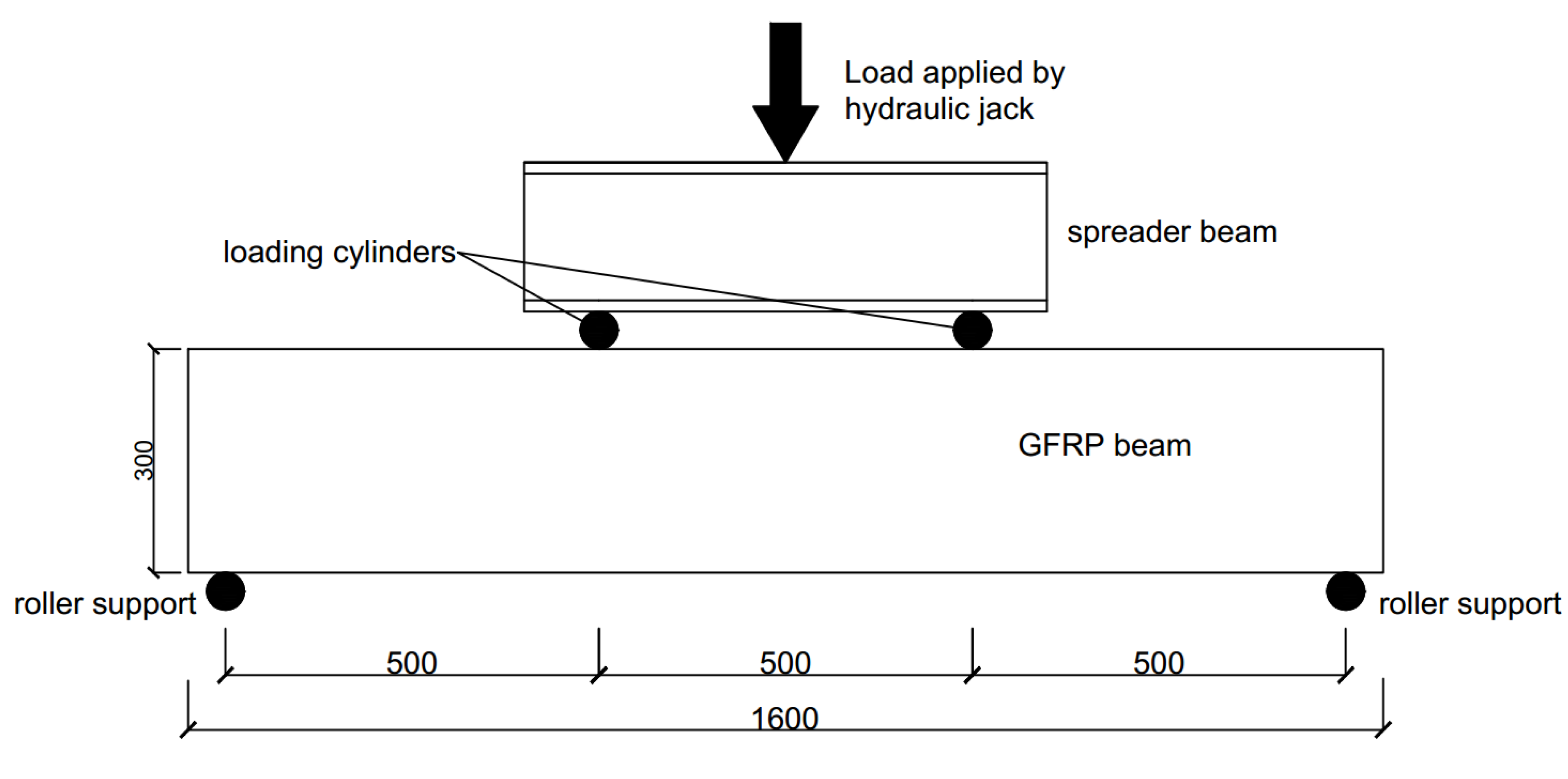
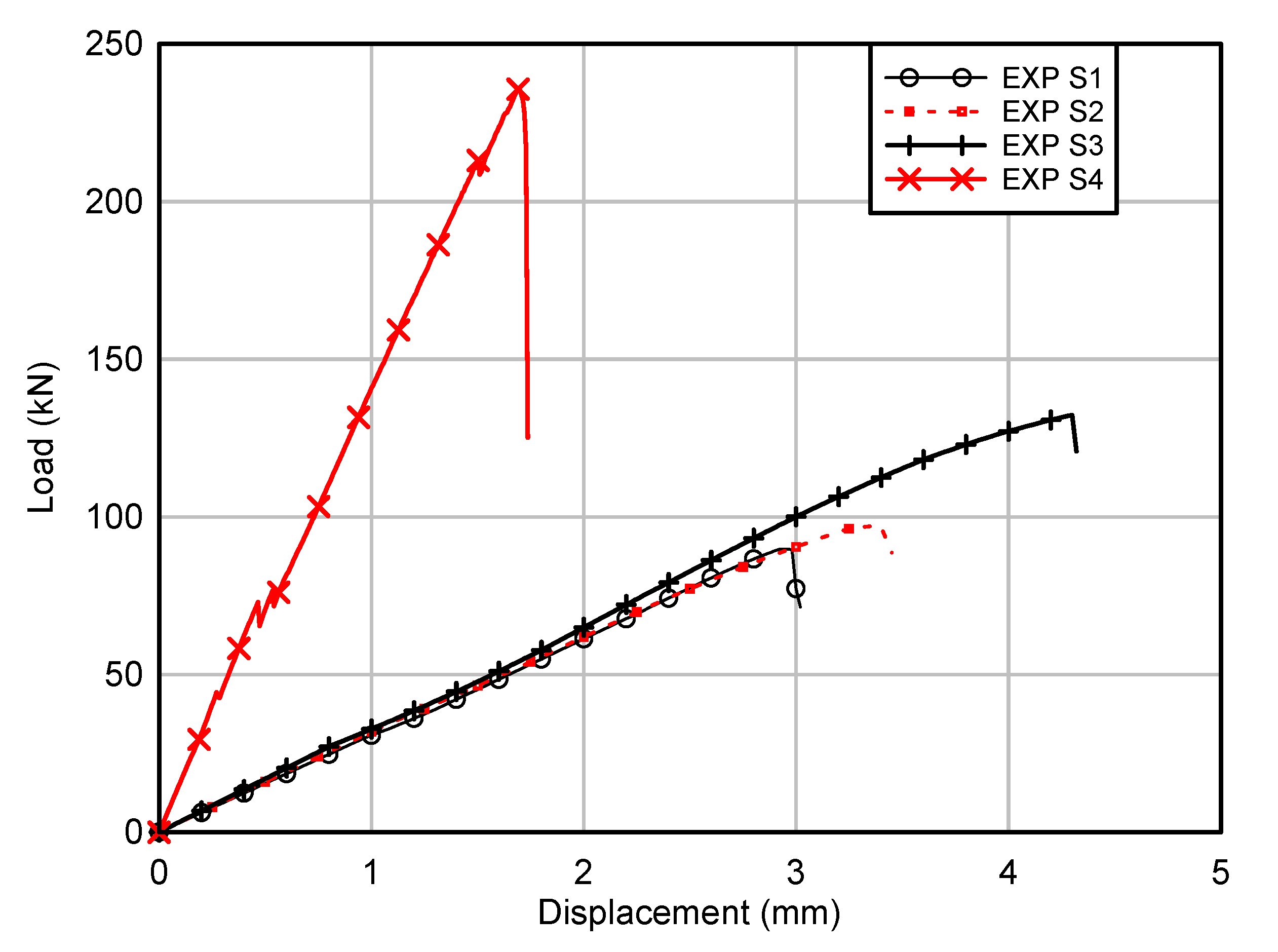
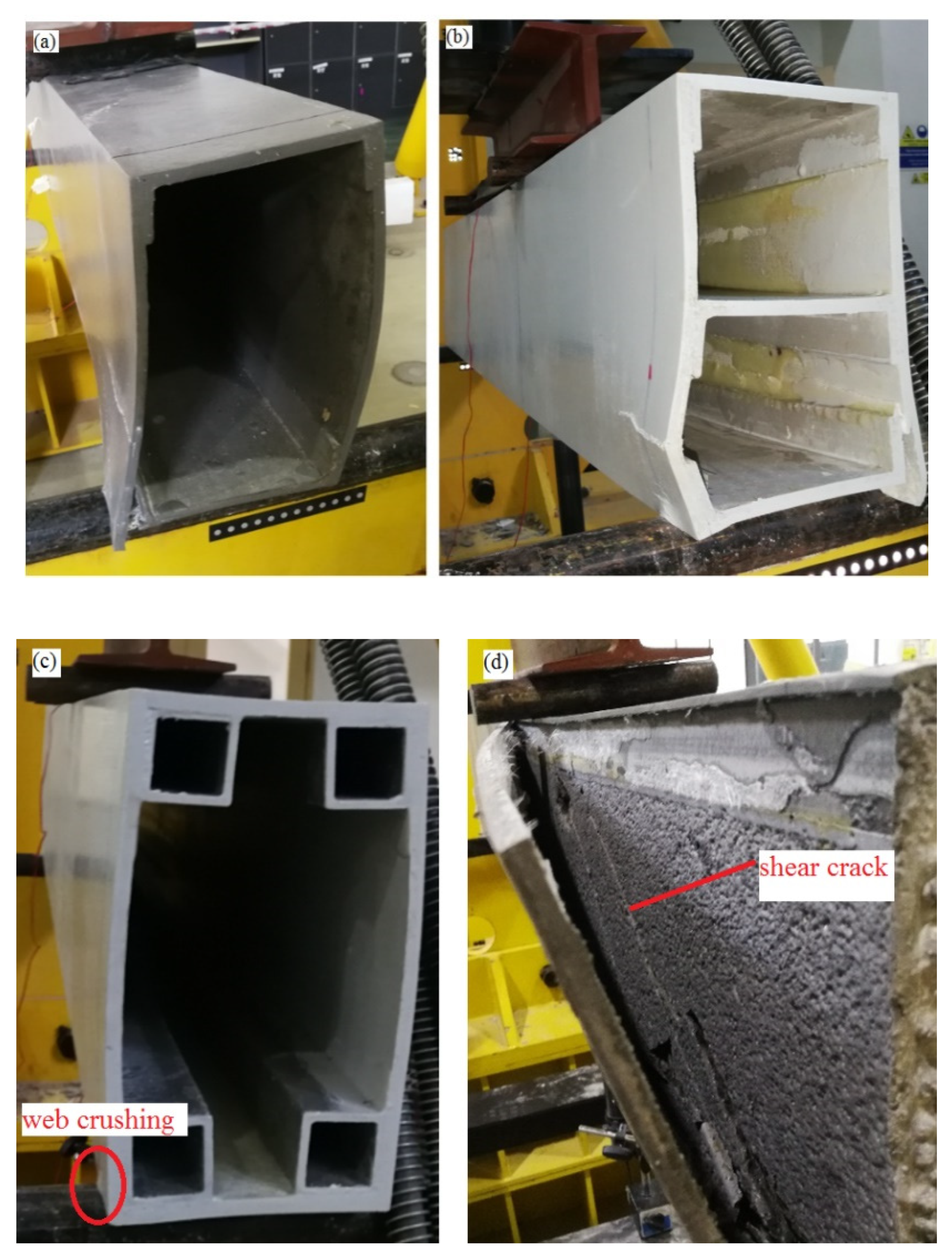
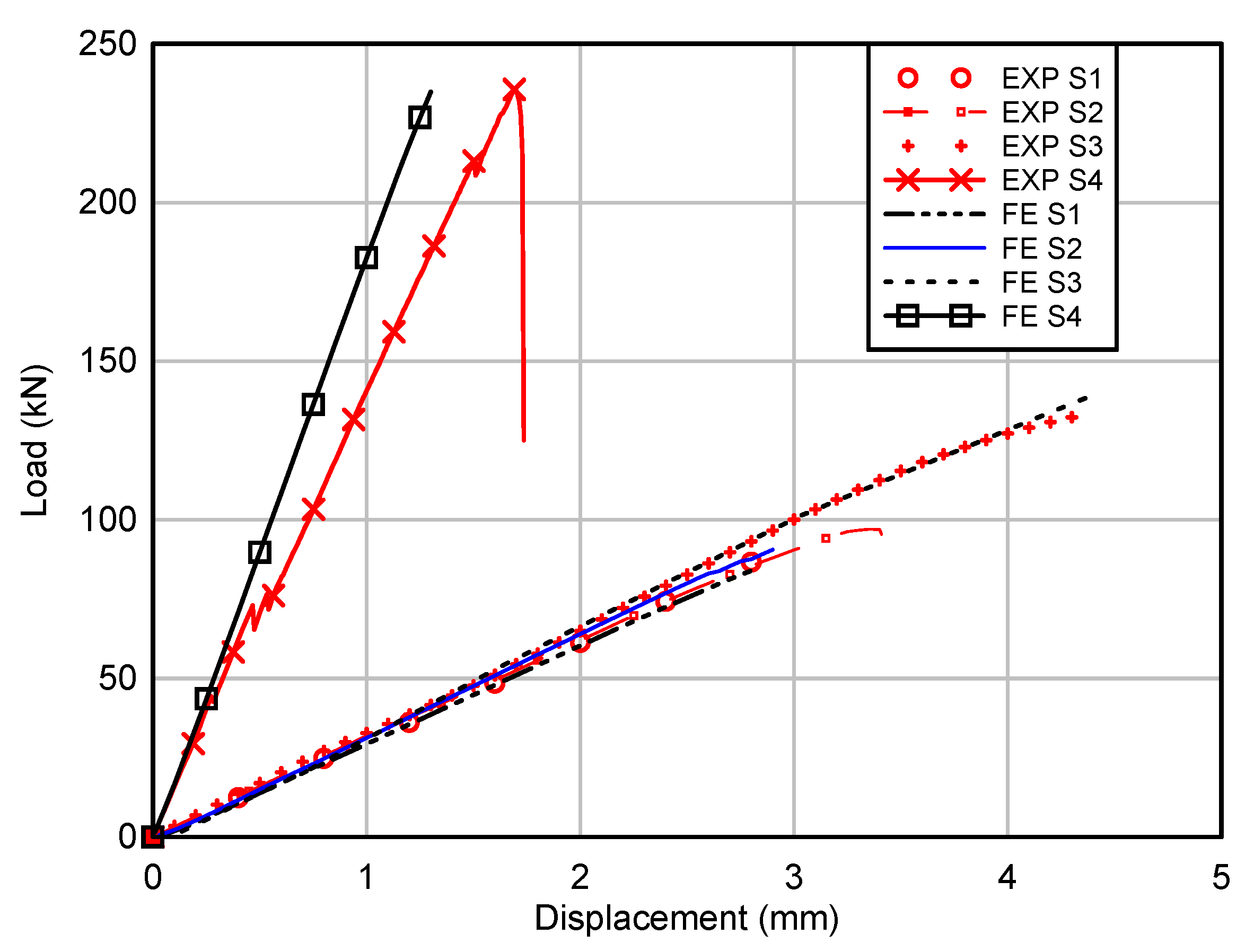
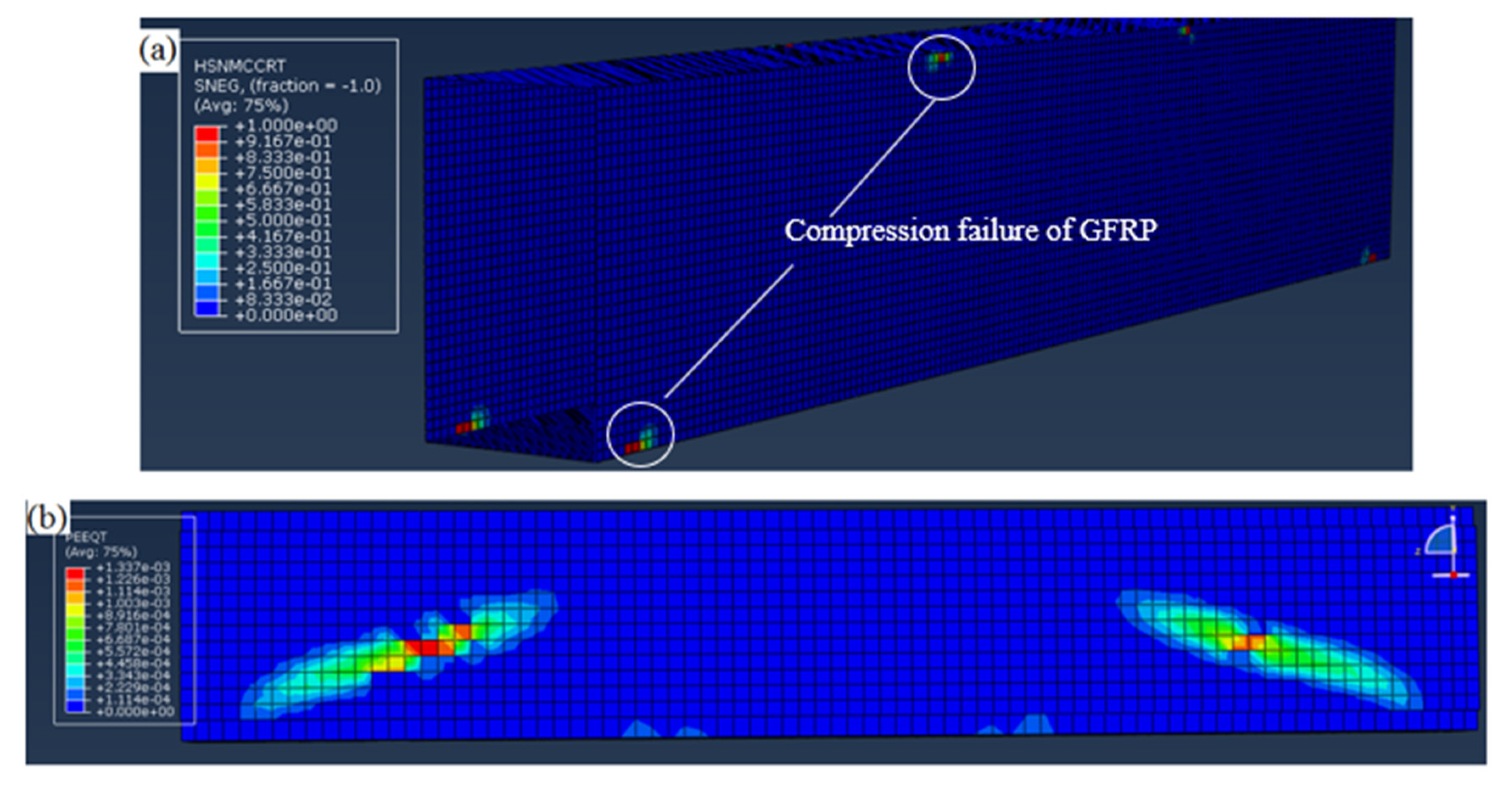
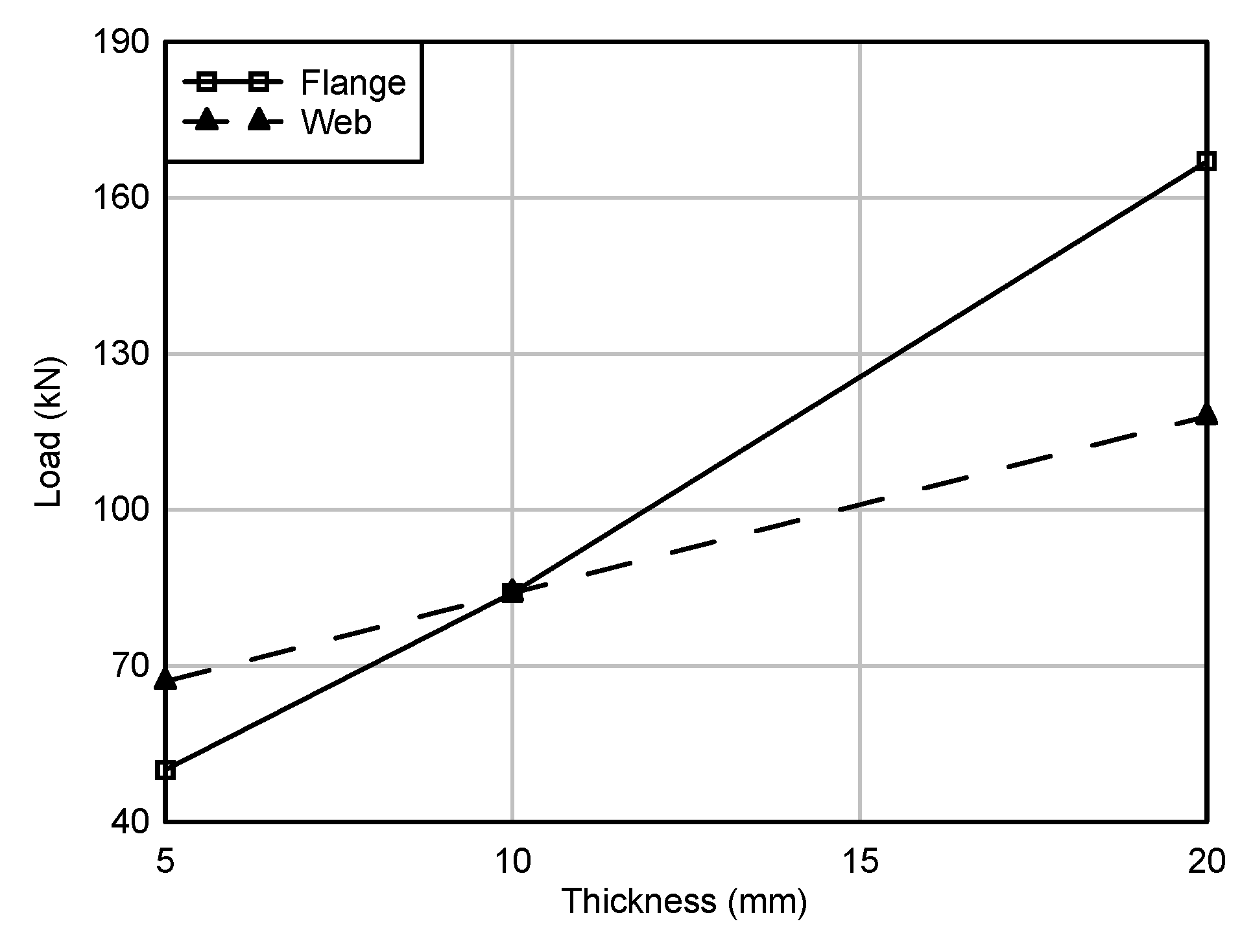

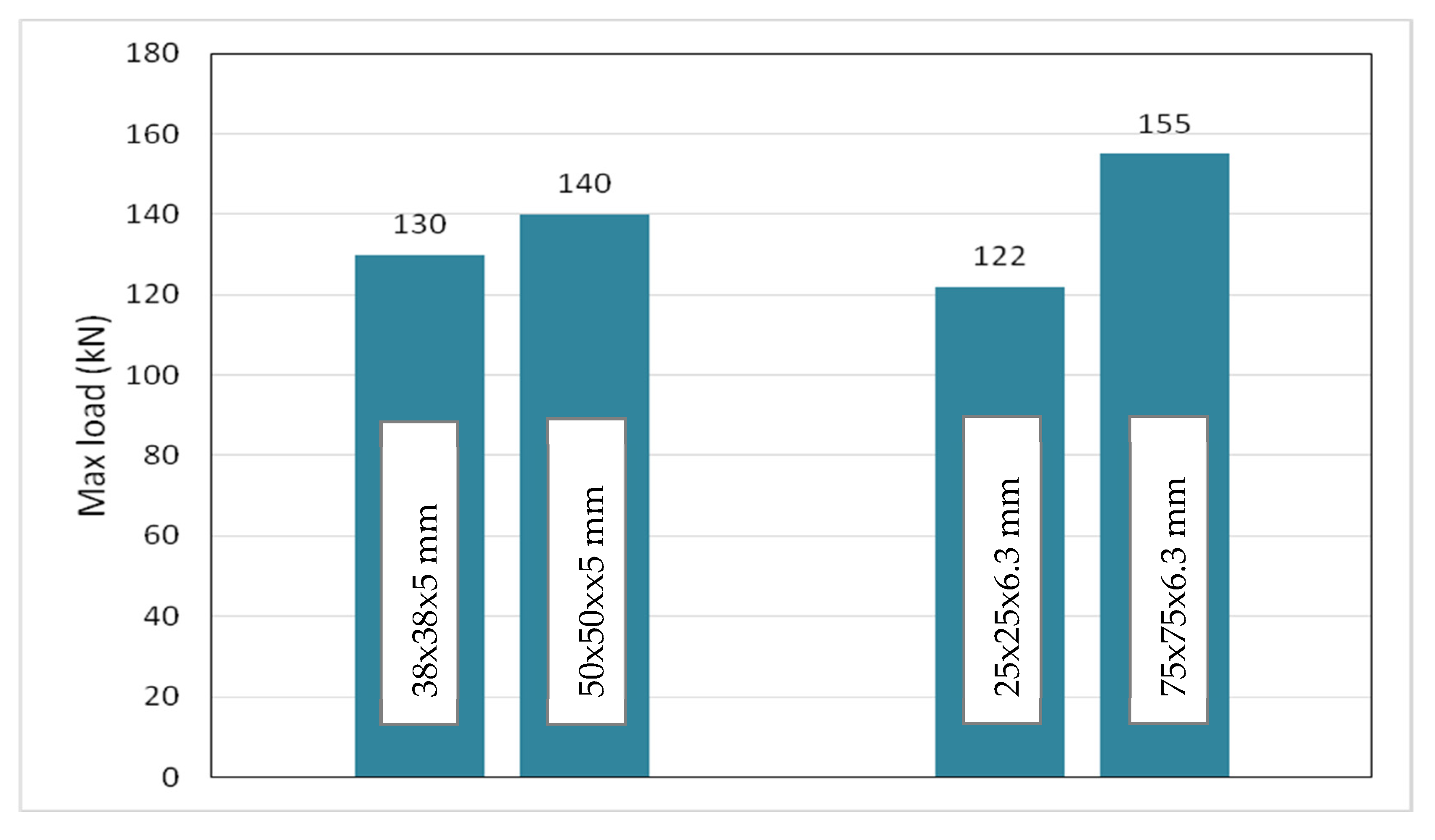
| Proportion | |
|---|---|
| Cement (kg/m³) | 424 |
| Sand (kg/m³) | 847 |
| LECA (kg/m³) | 327 |
| Water (kg/m³) | 170 |
| Dilation Angle, ψ | Eccentricity, ε | fbo/fco | Kc | Viscosity Parameter |
|---|---|---|---|---|
| 31 | 0.1 | 1.16 | 0.667 | 0.0 |
© 2020 by the authors. Licensee MDPI, Basel, Switzerland. This article is an open access article distributed under the terms and conditions of the Creative Commons Attribution (CC BY) license (http://creativecommons.org/licenses/by/4.0/).
Share and Cite
Kong, S.Y.; Wong, L.S.; Paul, S.C.; Miah, M.J. Shear Response of Glass Fibre Reinforced Polymer (GFRP) Built-Up Hollow and Lightweight Concrete Filled Beams: An Experimental and Numerical Study. Polymers 2020, 12, 2270. https://doi.org/10.3390/polym12102270
Kong SY, Wong LS, Paul SC, Miah MJ. Shear Response of Glass Fibre Reinforced Polymer (GFRP) Built-Up Hollow and Lightweight Concrete Filled Beams: An Experimental and Numerical Study. Polymers. 2020; 12(10):2270. https://doi.org/10.3390/polym12102270
Chicago/Turabian StyleKong, Sih Ying, Leong Sing Wong, Suvash Chandra Paul, and Md Jihad Miah. 2020. "Shear Response of Glass Fibre Reinforced Polymer (GFRP) Built-Up Hollow and Lightweight Concrete Filled Beams: An Experimental and Numerical Study" Polymers 12, no. 10: 2270. https://doi.org/10.3390/polym12102270
APA StyleKong, S. Y., Wong, L. S., Paul, S. C., & Miah, M. J. (2020). Shear Response of Glass Fibre Reinforced Polymer (GFRP) Built-Up Hollow and Lightweight Concrete Filled Beams: An Experimental and Numerical Study. Polymers, 12(10), 2270. https://doi.org/10.3390/polym12102270







